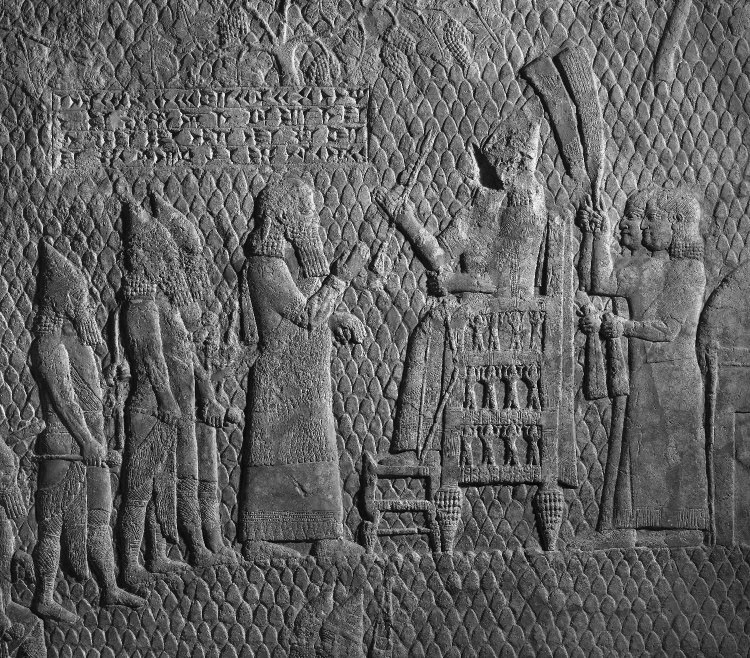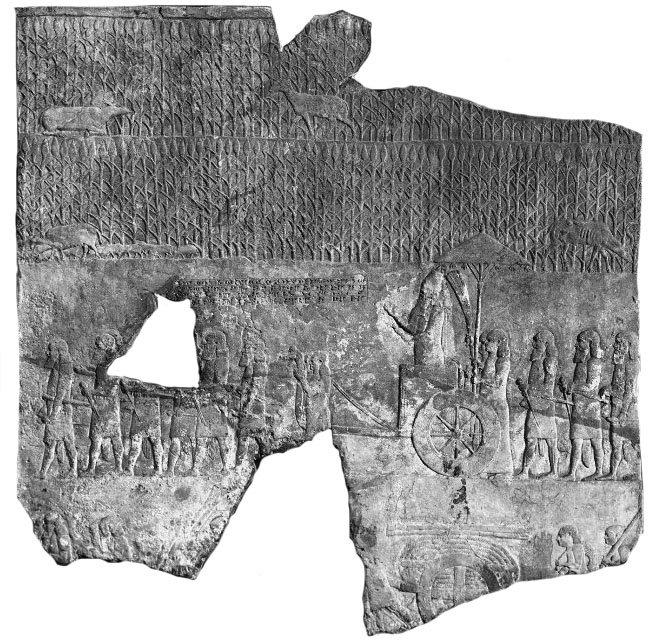- Home
- Explore RINAP Home Page
- Browse Online Corpus
- Access RINAP 3 Scores
- Access RINAP 3 Sources
- RINAP 3/1 Front Matter
- RINAP 3/1 Introduction
- RINAP 3/1 Text Introductions
- RINAP 3/1 Back Matter
- RINAP 3/2 Front Matter
- RINAP 3/2 Introduction
- RINAP 3/2 Text Introductions
- RINAP 3/2 Back Matter
- Oracc Lemmatization Colors
- Citing RINAP URLs
- Reusing RINAP material
- RINAP Downloads
Nineveh, Part 6
66 67 68 69 70 71 72 73 74 75 76 77
66 [/rinap/rinap3/Q003540/]
The so-called "Lachish Reliefs" from Sennacherib's "Palace Without a Rival" at Nineveh (Room XXXVI, slabs 12–13) have two scenes with captions over them. The present text appears over a scene showing the king sitting on a throne, with his feet resting on a stool (see fig. 12). Army officers stand before him, presumably describing the booty they had taken from Lachish, a fortified city of the Judean king Hezekiah. The second caption on the sculpted orthostats that once lined the walls of Room XXXVI is edited as text no. 67.
Access Sennacherib 66 [/rinap/rinap3/Q003540/]
Source:
Commentary
The numbering of the slabs in Room XXXVI cited here (nos. 12–13) follows R.D. Barnett (Barnett et al., Sculptures from the Southwest Palace 1 pp. 104–105) since his slab divisions are based on those of the actual sculptures now on display in the British Museum. This numbering differs in some instances from that on Layard's original plan of the room (nos. 11–12) since A.H. Layard ignored slab divisions. For further information on the numbering of the surviving slabs of Room XXXVI, with a concordance of the different numbering systems, see Barnett et al., Sculptures from the Southwest Palace 1 p. 105 n. 1.

Detail of BM 124911 (text no. 66), a slab showing Sennacherib sitting on his throne and reviewing the booty taken from the Judean city Lachish.
Bibliography
67 [/rinap/rinap3/Q003541/]
The second epigraph on the so-called "Lachish Reliefs" from Sennacherib's palace (Room XXXVI, slabs 12–13) appears over a scene showing the king's tent. The text is a label identifying Sennacherib's property. The first caption on the sculpted orthostats that once lined the walls of Room XXXVI is edited as text no. 66.
Access Sennacherib 67 [/rinap/rinap3/Q003541/]
Source:
Commentary
For information on BM 124912 and the numbering of the "Lachish Reliefs" slabs, see the commentary to text no. 66 and Barnett et al., Sculptures from the Southwest Palace 1 p. 105 n. 1.
Bibliography
68 [/rinap/rinap3/Q003542/]
Three sculpted orthostats that once decorated the interior of the South-West Palace at Nineveh have a short, one-line epigraph. The scene in all three instances portrays the king enthroned within his military camp. The slabs lined the walls of Room I (slab 9), Room V (slab 41), and Room X (slab 7).
Access Sennacherib 68 [/rinap/rinap3/Q003542/]
Sources [/rinap/sources/P466679,P466680,P466681]:
Bibliography
69 [/rinap/rinap3/Q003543/]
Traces of an epigraph, or possibly two separate epigraphs, are preserved on a badly damaged slab that is in situ in the throne room (Room I, slab 24) of the "Palace Without a Rival" at Nineveh. Not enough of the text(s) is legible to warrant an edition.
Access Sennacherib 69 [/rinap/rinap3/Q003543/]
Source:
Bibliography
70 [/rinap/rinap3/Q003544/]
An unpublished drawing of the surviving slabs of Room VII of Sennacherib's palace at Nineveh shows the rectangular casing of a short epigraph on one of them (slab 14). The text, which was inscribed in front of the image of the king, who is shown riding in his chariot, was not copied and thus its contents are not known.
Access Sennacherib 70 [/rinap/rinap3/Q003544/]
Source:
Bibliography
71 [/rinap/rinap3/Q003545/]
A very damaged epigraph, of which only one sign (URU "city") is preserved, is engraved on a sculpted slab that once decorated the interior of a room in Sennacherib's palace (Room XXXVIII, slab 17 or 18). The text, which is now known only from a nineteenth-century drawing, accompanies a scene showing a city in flames.
Access Sennacherib 71 [/rinap/rinap3/Q003545/]
Source:
Commentary
This epigraph may be the caption that A.H. Layard describes as follows: "over one of the castles could be traced a few letters, giving no clue, however, to its name or site" (Discoveries p. 342); a rough copy by him is found in his MS C (fol. 11r). The drawing of the slab gives the impression that the epigraph comprises two lines of text, of which only the first sign was copied. The preserved signs, if the text shown on Or. Dr. 6 no. 25b and Layard, MS C fol. 11r are in fact the same inscription, are URU É DIŠ IB? DI? (Layard, MS C fol. 11r). One could tentatively read these signs as URU.É-ku-ba-[at-ti ...], "The city Bīt-Kuba[tti ...]." If this proposed reading is correct, then this text may be a duplicate of text no. 56 (Layard, MS C fol. 57v), a two-line caption recording the capture and looting of the city Bīt-Kubatti. J.M. Russell, however, suggests reading the preserved signs of the caption copied in Layard, MS C (fol. 11r) as URU.É-mib/lu-[...]. Moreover, J. Jeffers (Iraq 73 [2011] pp. 87–116) has convincingly argued that the reliefs in Room XXXVIII (as well as those in Room XLVIII) depict images of Sennacherib's fifth campaign and, therefore, the partially copied epigraph drawn on Or. Dr. 6 no. 25b should refer to a city that was conquered and destroyed during that campaign. Sennacherib states in several of his inscriptions (for example, text no. 22 iv 26b–31) that he conquered and burned thirty-three cities in the vicinty of the city Ukku, Maniye's capital, and thus this epigraph could refer to any one of those cities. Following Jeffers' suggestion that the Room XXXVIII reliefs depict images of the fifth campaign, this inscription and text no. 56 are edited separately since this epigraph probably records the conquest of a city near Ukku, and not Bīt-Kubatti, whose capture and destruction is recorded in an epigraph in Room LX.
Bibliography
72 [/rinap/rinap3/Q003546/]
Traces of an epigraph are preserved on a sculpted slab that once decorated a wall of one of the rooms of the South-West Palace at Nineveh (probably Hall XLIX). Not enough of the text is legible to warrant an edition.
Access Sennacherib 72 [/rinap/rinap3/Q003546/]
Source:
Bibliography
73 [/rinap/rinap3/Q003547/]
A slab from Sennacherib's palace at Nineveh (Court VI, slab 60) is inscribed with a four-line epigraph stating that the king had large bull colossi transported to Nineveh from the region of the city Balāṭāya, where white limestone was quarried.
Access Sennacherib 73 [/rinap/rinap3/Q003547/]
Source:
Commentary
A mid-nineteenth century drawing of slab 62 of Court VI (Or. Dr. 4 no. 51; reproduced in J.M. Russell, Senn.'s Palace p. 109 fig. 56) depicts two complete four-line epigraphs. Russell suggests that both of those epigraphs could be duplicates of this text, which was engraved on slab 60 of that same room of the palace. This proposal cannot be confirmed at present.

BM 124824 (text no. 73), a slab showing Sennacherib in his chariot reviewing the progress of the construction of his palace.
Bibliography
74 [/rinap/rinap3/Q003548/]
Two sculpted orthostats in the same room of Sennacherib's palace at Nineveh (Court VI, slabs 66 and 68) are inscribed with the same six-line epigraph. The text refers to conquered foes quarrying white limestone in the region of the city Balāṭāya. The stone was used to sculpt large bull colossi that were stationed in principal gateways of the "Palace Without a Rival."
Access Sennacherib 74 [/rinap/rinap3/Q003548/]
Sources [/rinap/sources/P466687,P466688]:
Commentary
Although both exemplars are badly damaged, the inscriptions are still mostly legible and, as already noted by E. Frahm (Sanherib pp. 126–127), are exact duplicates. They have no variants and, therefore, no score is given on the CD-ROM. The master text is a conflation of exs. 1–2.
Bibliography
75 [/rinap/rinap3/Q003549/]
In Hall XLIX of Sennacherib's palace, A.H. Layard discovered fragments of three sculpted orthostats that had epigraphs. The Rev. E. Hincks provided a translation for one of these texts, which Layard then published in a popular account of his explorations of the Assyrian ruins at Nineveh (Discoveries p. 118). Hincks' translation reads: "Sennacherib, king of Assyria ... (some object, the nature not ascertained) of wood, which from the Tigris I caused to be brought up (through?) the Kharri, or Khasri, on sledges (or boats), I caused to be carried (or to mount)." It is clear, as J. Reade has pointed out, that this epigraph is describing a scene showing wooden objects being carried by raft from the Tigris up the Ḫusur river; from there, they were hauled up to the palace on sleds. Recently, J.M. Russell identified a copy of this epigraph in Layard, MS D (p. 17); an unpublished transliteration of Hincks submitted in a report to the British Museum in May 1854 (Add. MS 22097) aided in the identification of the inscription.
Access Sennacherib 75 [/rinap/rinap3/Q003549/]
Source:
Bibliography
76 [/rinap/rinap3/Q003550/]
This three-line epigraph, also unearthed in Hall XLIX of the "Palace Without a Rival," is described by Layard in his Discoveries (p. 118) as follows: "In the fragment of another epigraph, we have mention of some objects also of wood 'brought from Mount Lebanon, and taken up (to the top of the mound) from the Tigris.'" Layard's published description is based on infomation provided by the Rev. E. Hincks. J.M. Russell identified a copy of this epigraph in Layard, MS D (p. 17); an unpublished transliteration of Hincks submitted in a report to the British Museum in May 1854 (Add. MS 22097) aided in the identification of the inscription.
Access Sennacherib 76 [/rinap/rinap3/Q003550/]
Source:
Bibliography
77 [/rinap/rinap3/Q003551/]
This epigraph was described along with text nos. 75–76 by Layard in his popular account of the surviving slabs lining the walls of Hall XLIX of Sennacherib's palace (Discoveries p. 118). With regard to its contents, Layard states: "On a third fragment similar objects are described as coming from or up the Kharri or Khasri." The corresponding text has not been identified in Layard's unpublished manuscripts or in Hincks' report to the British Museum in May 1854 and thus no edition of the text can be presented here.
Access Sennacherib 77 [/rinap/rinap3/Q003551/]
Source:
Bibliography
A. Kirk Grayson & Jamie Novotny
A. Kirk Grayson & Jamie Novotny, 'Nineveh, Part 6', RINAP 3: Sennacherib, The RINAP 3 sub-project of the RINAP Project, 2025 [http://oracc.org/rinap/rinap3/RINAP32TextIntroductions/Nineveh/Part6/]